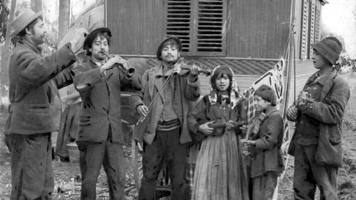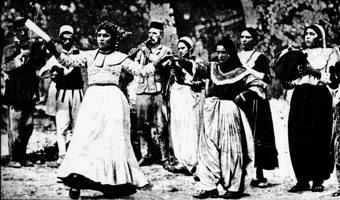
|
The Society of Folk Dance Historians (SFDH)
Rom Music and Dance
[
Home |
About |
Encyclopedia | CLICK AN IMAGE TO ENLARGE |

|
Throughout Rom History, music and dance have been an integral part of their culture as well as an excellent source of income from the non-Rom world.
Romani learn the art of dance from early childhood. They are not formally taught – they learn a huge vocabulary of dance movements by imitation. Children are encouraged to dance and through dance learn many of the basic sexual roles allowed within Rom society. There are distinct male and female steps, step patterns, and styles. Dance is also considered a pleasure to behold, and so, at times, one person will dance for another as a "gift."
Among the American Rom, traditional dance takes the form of either the Basso or the Kolo. The Kolo is done only at weddings, and consists of a long line of dancers doing a few steps repetitively. The dance is simple, with no competition between dances.
The Basso, on the other hand, can be done spontaneously at any occasion when Romanis gather. It can be done either as a solo, or as a couple, but if it is couple, the partners don't have any physical with each other. The dance is highly competitive, and there is such interaction between the dancer and the audience. As in other aspects of Rom life, male and female roles are clearly different. Male steps include squats, rhythmical stamping, and foot slaps. Females have a fast dance section, followed by a slow, lyrical section, followed by another fast section. Their torsos and hands are used a lot, with many expressive hand movements.
As previously stated, Romanis and music have been tightly interwoven throughout their history. Music is a profession that has continuously provided Romanis with a viable economic niche in Balkan society. In Bulgaria, Romanis have a virtual monopoly of some instruments, namely the zurna (oboe) and the tûpan (two-headed drum). Whatever instrument they play, Romanis learn the repertoire of the local peasantry in order to become indispensable at festivities such as weddings, baptisms, house warmings, and saint's day festivals.
 Music means more within the Rom society than 'just a source of income'. There is music and dance played by Romani for Romani. Much of this is rarely heard or seen by the "gajo" (non-Romani). An example of this to be found is the Kjuchek, a type of music and dance heavily influenced by Turkish music, attributed to the Bulgarian Romani.
Music means more within the Rom society than 'just a source of income'. There is music and dance played by Romani for Romani. Much of this is rarely heard or seen by the "gajo" (non-Romani). An example of this to be found is the Kjuchek, a type of music and dance heavily influenced by Turkish music, attributed to the Bulgarian Romani.
When we speak of music by and for Romani, we come to an argument amongst scholars regarding the nature of Rom music. Arguments center around the definition of "pure" Rom music as against "borrowed peasant tunes." A paper by Carol Silverman, "Gypsy Ethnicity and the Social Contests of Music," written in 1977, addresses this argument. In it, she states that music is an expressive act which derives its meaning from its performance context rather than from its origin. The remainder of this article is based on that information taken from her paper.
The first thing to remember is that music means work to many Romani in the Balkans and Central Europe. (This doesn't necessarily apply to those in the United States.)
In all probability, Romanis were musicians from the beginning of their world-wide migration; certainly it was compatible with nomadic life. But music, although it may be one of the oldest Rom occupations, is ONLY ONE of a great number of Romani trades. A Romani's occupation depends on what is needed, what is available, what is profitable, and what fits into Rom life style in a particular country. These conditions may change as often as weekly; thus, Romanis are extremely adaptable when it comes to occupations. Some of these occupations have become 'traditional' because over the years they have met the above-mentioned needs. Music and fortune-telling are two of these 'traditional' occupations.
Romanis as professional musicians perform for non-Romani audiences for pay at various events. One musician might know the folk dance tunes of three or four countries or eight or nine different cultures. Whatever the locality and the occasion demands, the Roma will learn. Thus, their tastes are eclectic and they may be called multi-musical. They do not passively assimilate the music and customs of the countries of their adoption; rather, they become competent performers, often to the extent of becoming the most typical exponents and practitioners of that music.
So far we have discussed exoteric Rom music, that is for outsiders. Turning now to esoteric Rom music, we find that among themselves, Romani will often play precisely the same music they play for outsiders, plus another body of music consisting of songs in the Rom language. These songs are usually not sung for outsiders and they often deal with typical Romani themes. Although there is this separate body of music enacted only in esoteric contexts, there is still a broad stylistic unity in the music a Rom performs. The following list of features applies to the music of the Rom in the Balkans and their descendants in the United States. All features are stated in comparison to the host country's music:
- Greater use of pitches not in the Western tempered system,
- a great deal of melodic variation from stanza to stanza,
- a great deal of melisma (a group of notes sung to one syllable of text),
- a great deal of ornamentation,
- a great deal of vibrato,
- a great deal of improvisation,
- a great deal of tempo flexibility, including rubato the temporary disregarding of strict tempo to allow an expressive quickening or slackening, usually without altering the overall pace), prolonged rests, and syncopation,
- a great deal of emotion, shown by actual crying in songs and abrupt volume change.
These features apply to instrumental as well as vocal music.
To further illustrate the exoteric/esoteric dimensions of perfomance, let us move from music to dance, using Yugoslavia as an example. Four categories of Yugoslav Rom dance can be identified:
- Dances performed by Roma for Roma (esoteric),
- dances performed by Roma for outsiders for money,
- dances performed by Romani dance ensembles for outsiders for no money,
- dances performed by non-Romani ensembles imitating Roma (Ciganske Igre).
 As reported by Elsie Dunin in "Gypsy Wedding: Dance and Customs," esoteric Rom dances consist of two types; Čoček and Ora. Čoček is performed indoors by segregated groups of men or women while ora are performed outdoors by mixed groups. In previous generations, Čoček used to be performed by Romani women for non-Romanis for money, and in most cases, the erotic nature of the dance is noted. The same Čoček, however, performed esoterically, has no erotic connotations; in fact, Čoček is performed under strictly segregated conditions – indoors with the curtains drawn. The same dance, then, has opposite cultural meaningsin two different contexts. For the public audience, Roma capitalize on the erotic Rom image which has no validity esoterically.
As reported by Elsie Dunin in "Gypsy Wedding: Dance and Customs," esoteric Rom dances consist of two types; Čoček and Ora. Čoček is performed indoors by segregated groups of men or women while ora are performed outdoors by mixed groups. In previous generations, Čoček used to be performed by Romani women for non-Romanis for money, and in most cases, the erotic nature of the dance is noted. The same Čoček, however, performed esoterically, has no erotic connotations; in fact, Čoček is performed under strictly segregated conditions – indoors with the curtains drawn. The same dance, then, has opposite cultural meaningsin two different contexts. For the public audience, Roma capitalize on the erotic Rom image which has no validity esoterically.
Recently, a new dance phenomenon has appeared in Yugoslavia – Romani dance ensembles. In seeking recognition as a national minority, the Roma have followed the path of other minorities in publicly presenting their folk music and dance. Romani dances were altered to conform to their idea of what a proper Yugoslav ensemble should be. All distinctions between segregated and mixed dances broke down, Romani choreographers employed theatrical conventions similar to other groups, such as complicated geometric patterns. Among Roma, of course, none of this would be found. The ensembles dressed in costumes Romanis would never wear. In general, the "put on a show" of what they thought the public wanted as Romani folklore. One ensemble even imitated what peasant groups did to portray the "wild Roma;" in other words, the Roma imitated the imitations of themselves by non-Romanis.
The most important parameter of Rom musical performance, then, is audience. The origin of the music matters little; rather, its performance is meaningful socially. When Roma perform for non-Roma they play to the damands of that audience. When Roma perform for other Roma, they activate a different set of performance rules and meanings.
What effect does this catering to public taste have on group folklore? It has a great deal of effect, but in selective ways. The underlying philosophy with regard to the host culture can be summarized as follows: if it fits in with Rom values, by all means adopt it. This is true of songs and dances as well as clothes, hairstyles, languages, houses, and cars. But it must not conflict with core values; thus, neither socializing with non-Romanis nor breaches in the taboo system are permitted.
Romani folklore has changed for centuries and will continue to change precisely because the Rom is a master of adaptation and flexibility. He takes the essence of popular culture and molds it to conform to the Romani life style. This interaction with the surrounding culture makes Roma unique and may, in fact, define their ethnicity.
BIBLIOGRAPHY
- Metzgar, Penelope Sue Willens. "An EthnographicFilm Script for the Dance of the L.A. Gypsies," 1974.
- Silverman, Carol. "Gypsy Ethnicity and the Social Contexts of Music," 1977.
DOCUMENTS
- American Rom 1987, an article.
- American Rom 1995, an article.
- Bibliographic Notes on Romani Studies, an article.
- Gajo in the Romani Camp, an article.
- Rom, a culture.
Used with permission of the author.
Printed in Folk Dance Scene, February 1987.
This page © 2018 by Ron Houston.
Please do not copy any part of this page without including this copyright notice.
Please do not copy small portions out of context.
Please do not copy large portions without permission from Ron Houston.